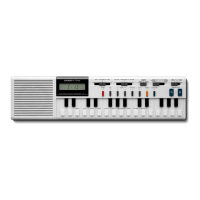9. ADSR Function
— 23 —
With this function you can create your own original sounds.
Generally, a tone (character of a sound) is determined by pitch,
loudness (strength) and timbre (tone color). Also in addition to
the threee elements mentioned above, there is another impor-
tant factor for determination of a tone; so called “envelope” (the
characteristic of the attack and decay of a sound). In short, the
change in the loudness (amplitude) with the passage of time (du-
ration). For instance, a sound that slowly builds in loudness such
as that of a violin. Another example would be a sound such as
that of a guitar where the loudness peaks momentarily when you
pick the string and then reduces quickly. These and many other
sound wave variations are possible. The illustration shows an
example of the envelope of a Piano. The graph shows the time
(duration) horizontally and amplitude vertically. This is called an
“envelope curve”. The ADSR function affects 5 elements (Attach,
Decay, Sustain level, Sustain time, Release time) in determining
the envelope curve and created many sound wave variations.
• ADSRisanacronymforthe5elements.
• Howthesoundvariationsareformed.
A : Attack time
D : Decay time
SL : Sustain level
ST : Sustain time
R : Release time
AMPLITUDE
TIME (DURATION)
A
D
ST
SL
R

